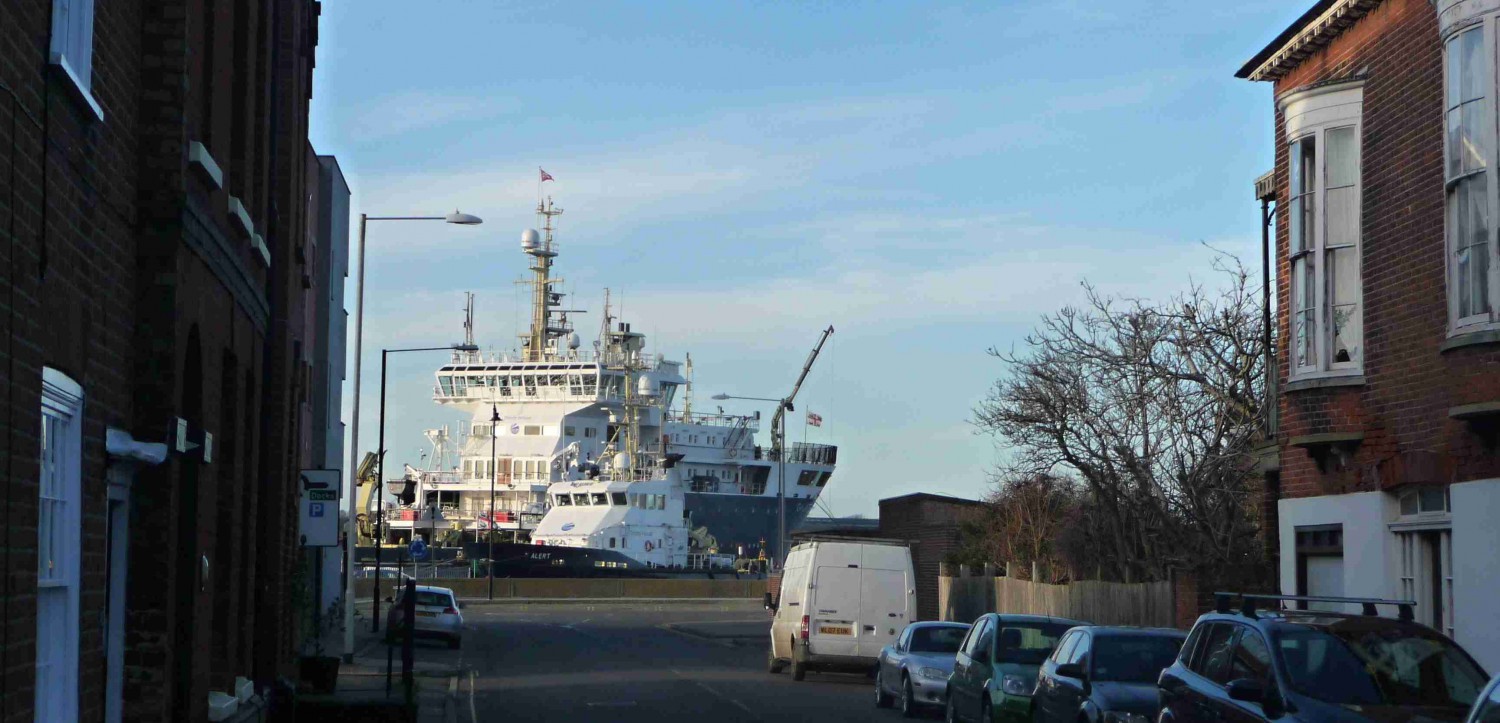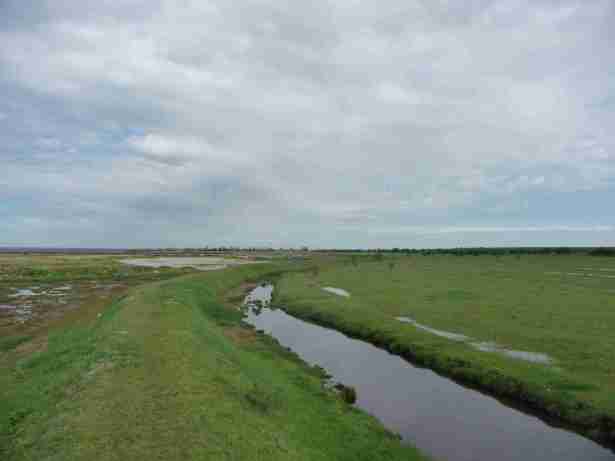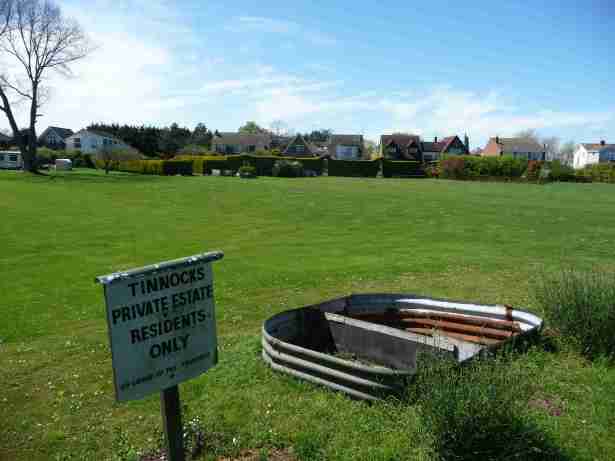30th April 2012
Maylandsea – Ramsey Island – St Lawrence’s Bay – Bradwell – St-Peter-on-the-Wall
Arriving at St Peter’s chapel, Key West and myself look back across the Blackwater in the direction from which we have come. It has taken us an hour to drive here, but, as the crow flies, our starting point is probably not much more than ten miles away. Key West claims that it is the first time he has ever been on a walk, apart from giving his dogs a couple of miles every day. At the end of the walk, I ask him to choose the name under which he will appear in this blog; ‘Permanently Disabled’ he suggests, edging himself gingerly into a seat outside the pub. This blog however, as well as being committed to the anonymity of its participants, strenuously upholds the principle of seeing the ability, not the disability, and to my mind, walking from Maylandsea to Bradwell is a doddle compared to being a short-order chef, as he once was, dishing out hash browns and sunnyside eggs to demanding Florida fishermen. Key West it is then.
Ebb Tide and Master F. turn up and we’re back to Maylandsea for the start of the walk. We retrace our tracks along a muddy footpath to the end of Mayland Creek, and along the sea wall. It’s been heavy rain over the past couple of days and there is a lot of water lying on the fields. For now though, there are clear blue skies, and the prospect of a warm, sunny day. A hare sprints across the field into a hedgerow; not much to see in the way of birdlife, a couple of swans and some shelduck, most of the geese probably gone by now. Osea island is just opposite, its large, Edwardian buildings glistening enigmatically in the sunshine. Key West observes that it’s strange that we can’t see Bradwell power station, possibly concerned that, if we’re out of sight of the biggest structure on the Essex coast, we must have miles to go.
On our last walk, we passed the site of the Battle of Maldon, where the rivers ran with Saxon gore, and it’s hard to believe, contemplating the enormous skies, the serene curve of the sea wall and the white sails scudding across the water, that the Blackwater Estuary is still a battleground, although with slightly less decapitation than in 991. The issue of coastal realignment, for example, pits environmentalists against farmers, fishermen and landowners, with environmentalists often being cast as office-bound fantasists, interfering with nature; the issue was even taken up by the Telegraph, which railed against the potential loss of golf courses and tourist revenue. You don’t, however, have to walk very far along the Essex coast to realise that it is in no way a ‘natural’ construct. Almost every inch we have walked so far has been sea wall, constructed over the last four hundred years or so, under what were then different climatic conditions, in order to claim agricultural land from the salt marsh – never an entirely benevolent enterprise. In a sense, most of its 400 miles are not ‘sea wall’ at all, but earth embankments which rely on the outlying saltmarsh to deflect the force of the sea. As the salt marsh is washed away, the sea wall is an inherently vulnerable bulwark.
As walkers,we four are not neutral bystanders in the battle of the Blackwater, we represent a minor faction of spear-carriers, albeit an entirely impotent one. At the head of Mayland Creek (still no sign of the power station), past a cluster of holiday chalets, a loop in the sea wall, and we approach Stansgate Hall Farm, the garden of which directly abuts the sea wall, and we have to cut inland a few yards and walk up a lane back to the Coast. Stansgate is of course the home of Tony Benn, formerly Viscount Stansgate, and as we walk past the front gate, we wonder if he might be pruning his hedge and invite us in for a cup of tea; I would like to ask him, as someone who had been a target of the full mendacious power of the Murdoch press in the 1980’s, whether, 30 years on, he got any satisfaction from the fall-out of the phone-hacking scandal, and the declaration of Rupert Murdoch as ‘not a fit person’ to run a corporation, but the hedges of Stansgate have a distinctly unpruned look, complimenting the battered sheds and the derelict classic car in the grounds, and my wish has to  remain unfulfilled. However, Stansgate is itself a battleground and Tories have had huge fun over the fact that right of way is restricted around the house; last week, the landlord of a nearby pub alerted Ebb Tide to the fact that we couldn’t walk around Stansgate -“that’s socialists for you”, and, in 2008, the ever-reliable Telegraph (I read it so that you don’t have to) printed a prominent article about this limited access, in the context of the ‘right to roam’ legislation. The Benn family simply stated that they would do as the legislation required, however, although access looks feasible, and we’ve encountered worse barriers before, we don’t push the point. Back onto the sea wall through the marina of the Marconi yacht club, and Bradwell appears ahead of us; “Bloody hell”, says Key West, “It’s miles away”.
remain unfulfilled. However, Stansgate is itself a battleground and Tories have had huge fun over the fact that right of way is restricted around the house; last week, the landlord of a nearby pub alerted Ebb Tide to the fact that we couldn’t walk around Stansgate -“that’s socialists for you”, and, in 2008, the ever-reliable Telegraph (I read it so that you don’t have to) printed a prominent article about this limited access, in the context of the ‘right to roam’ legislation. The Benn family simply stated that they would do as the legislation required, however, although access looks feasible, and we’ve encountered worse barriers before, we don’t push the point. Back onto the sea wall through the marina of the Marconi yacht club, and Bradwell appears ahead of us; “Bloody hell”, says Key West, “It’s miles away”.
Master F. is a connoisseur of pill-boxes – the concrete machine-gun nests, dating from WWII, that are particularly prolific along this stretch of coast. “Type 22”, “Type 23”, he reports at regular intervals, and at one point, he disappears into the back door of an unusual double-fronted structure (Type 27?), but apparently, it’s pitch black inside and he can’t see anything. The rest of us tend to scoff, and I have suspected that he is making these numbers up, but I am humbled by a visit to pillboxes.co.uk which reveals that there are not only types 22 to 28, just as Master F. has informed us, but also a lozenge pillbox, an earred pillbox, a ruck pillbox and an Alan-Williams turret. I have known Master F. for many years, and never suspected this facet to his knowledge and I think it must take the unique ambience of the Essex coast to reveal these hidden depths in people, and we should be grateful to him for expanding our horizons.
Type 22 is the most common design. It is a regular hexagon with walls approx 0.3m thick by 1.8m long. Most have a loophole on each side of the hexagon, apart from the side with the entrance, however some have a low entrance so that so that an additional loophole can be accommodated or a smaller loophole next to the entrance.
We move across Ramsey Island, which doesn’t seem to be obviously seperated from the mainland – “no longer a genuine Island at all” says Ian Yearsley . This is a privatised stretch of coast with neatly manicured lawns bordered by ‘keep off’ notices, large, ostentatious, statement houses; we are facing the sweep of St Lawrence’s Bay, fringed with shingle, and extending into a wide crescent of low-tide mud. At one point, we are forced onto the shingle for several hundred yards, because the gardens of the houses extend to, and include, the sea wall.
Towards the end of St Lawrence’s bay, several large breaches have been made in the sea wall, and a large area of land is reverting to saltmarsh.
Passing through Bradwell Marina, and after a brief refreshment stop, we are upon the power station, principal landmark of the coast, from a distance appearing as a dull grey silhouette, but now resplendent in its minimalist glory. Reading the website for the Nuclear Decommissioning Authority, I am, for some reason, surprised and strangely reassured that Bradwell power station has an address, telephone number and postcode, just like a normal person;
Bradwell Power Station
Bradwell-on-sea
Southminster
Essex
CM0 7HP
Tel. 01621 776331
“If you know the extension number you require, please dial it now, or hold for reception.”
….”Hello, Bradwell Power Station; Security.”
“Does the station still have a visitor or information centre?”
“Ooh no, we haven’t had that for a long time, not since 9/11. It’s all closed I’m afraid.”
I resisted the temptation to ask if it were possible to buy plutonium rods or weapons-grade material, for fear of being targeted by agents of surveillance. Operating between 1962 and 2002, the power station is in the process of being ‘decommissioned’, and the NDA give the timetable for demolition, stretching over the next eighty years;
| 2083 – 2092 |
Final site clearance |
| 2015 | Site enters Care and Maintenance phase During this stage the reactor is left to cool. Most of the structures are removed, and the reactor building is left in a safe state which requires minimum supervision, until final site clearance. |
| 2011 | Turbine Hall deplanted and demolished |
| 2009 | Partial drain down of cooling pond |
| 2005 | Defuelled Once a site has finished operating and the fuel has cooled down it can be removed and taken to Sellafield for reprocessing. |
Passing the power station, the landscape flattens, the wind picks up; we are now leaving estuary and back at the North Sea proper. Beyond the eleven concrete barges planted to prevent erosion, there are a couple of windsurfers expertly and at speed, negotiating the wind and currents; the sea wall describes a smooth arc around the end of the Dengie Peninsular towards St Peter’s Chapel, the end of our walk. I point this out to Key West; “Bloody hell!”, he responds,”It’s miles away.”






